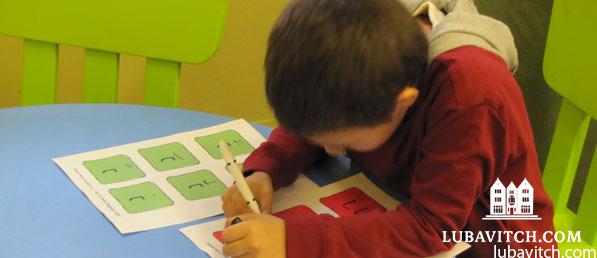(lubavitch.com) Now children—and adults—can learn to read Hebrew in 20 hours or –less. For real. Chabad representatives in California have formally launched a new Hebrew reading program that makes learning the Aleph Bet quick and easy for kids, adults and children with special needs.
The difference between learning to read Hebrew at Chabad of LA’s Jewish Learning Academy and through the traditional method is as obvious as the sack full of toys and props—forty-four in all, one for each sound in the Hebrew language—that Rabbi Eyal and Tzippy Rav-Noy distrubute as they teach.
For Jacob Rokah, 7, the tongue depressor helps to remind him to read “aaah” whenever a Hebrew vowel shaped like a long flat line appears. His mom. Ruth Rokah, is incredulous about Jacob’s mastery of Hebrew reading. When he started the class, she says, Jacob knew only five letters of the Hebrew alphabet. Now “he can pick up a siddur and read. Jacob learned to read Hebrew faster than his older brother who took the SAT at age 11.”
Jacob was among the first group of students who were taught to read using this new method. Two weeks ago JLA broke new ground when it partnered with the local Friendship Circle to adapt the program for learning disabled children and children with disabilities such as Down syndrome and autism.
The method’s success has the Rav-Noys adapting the strategy to teach adults, as well. The next project is packaging the course for use by other schools and for home study via the web, and the Rav-Noys are working hard to make this happen.
Learning to read Hebrew is often a gateway to getting more involved with Jewish life. “People want to connect to Judaism through language. Signing up for Hebrew classes can be less threatening than committing to learning about Judaism,” said Mrs. Rav-Noy.
David Rothman, an LA-based appliance repairman, who learned to read Hebrew at the Rav-Noys’ class for adults some years back, said the ability to decipher Hebrew letters made “being religious less intimidating. I know many prayers by heart, but it helps to look down at a page and read what we are saying.” Other graduates of the reading program now lead Shabbat services at JLA.
The know-how to create a reading course that works for children with different needs and abilities, as well as adults, is a skill the Rav-Noys have honed through years of experience as educators. The couple founded the JLA in 1999. For years, the Rav-Noys used existing curricula and methods, to teach Hebrew to hundreds of Los Angeles adults.
While preparing to teach a course on kabbalistic notions of personality Rabbi Rav-Noy came upon something that ultimately gave birth to this new method of Hebrew reading education. According to Jewish mysticism, three elements blend to create a personality – mind, heart and instinct. As the brochure for the JLA Hebrew reading method explains: “The mind visualizes a subject as a whole. The heart idenfities with it on an emotional level… The instinct gives the student ownership of the subject.”
When a lesson fully incorporates these three components, “it reaches people,” said Mrs. Rav-Noy. Hence the curriculum’s name: “CAP IT! ” for Concept And Personality Integration.
Starting a children’s education program was a departure from the adult education mission of the JLA. But the economic downturn left many parents unable to pay Jewish school tuition, and forced them to pull their children from Jewish day schools. Calls started coming in to the JLA, and the Rav-Noys decided to pilot CAP IT.
When Leora Lewis brought her children Joseph, 9, and Sara, 7, to the CAP IT class, the kids were not meditating on the kabbalastic underpinnings of the Hebrew language lesson. They were out to have some fun. Every class had three sections, one each for mind, heart and instinct.
“Mind” began with handing out a toy for the sound of the letter – a drill for the /d/ sound of the dalet. Then Rabbi Rav-Noy played a song for the letter on his guitar. Seven minutes later the kids moved on the “heart” section, and they completed the “instinct” portion – where they drew the letters in rice or sand or with markers for another seven minutes. Only after playing and singing and drawing the letter did Joseph and Sara try to read the letter. “By the time they got to the reading part it was not stressful for them. They were not afraid of it,” said Mrs. Rav-Noy.
“The children liked the program, and they wished it would continue,” said Lewis, who pointed out that one of the program’s great strengths is the Rav-Noys themselves.
“Eyal and Tzippy’s love for what they do is so great.”

Be the first to write a comment.